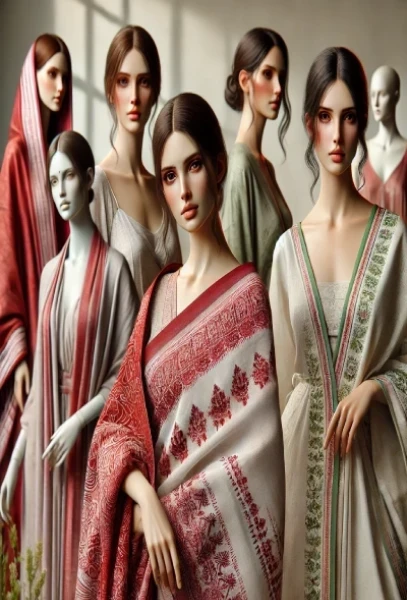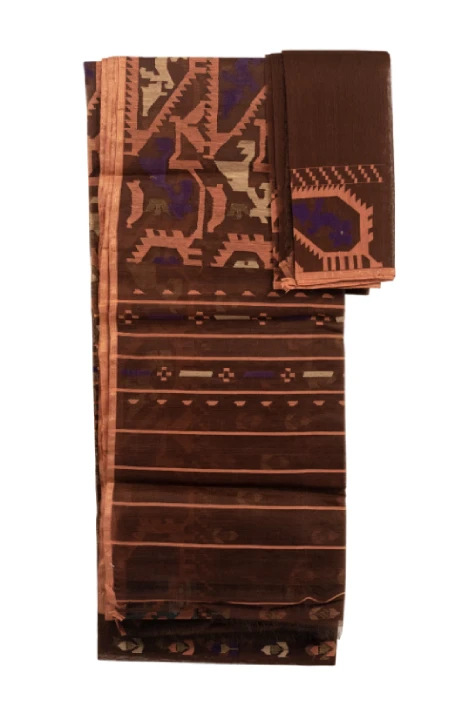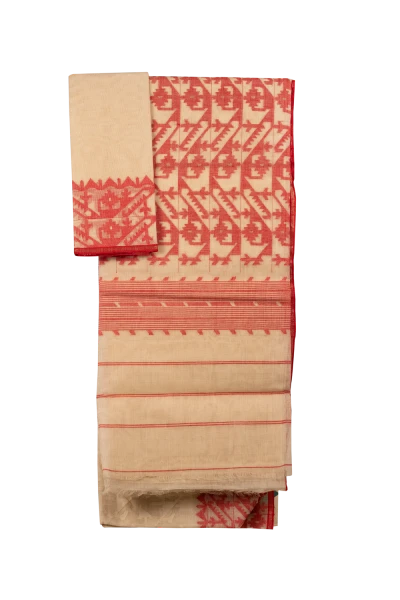Eco-Friendly Fashion for Making Women Gorgeous in 2024

But in the recent past, fashion has gone a notch higher; it is not just about looking good but about making correct decisions that would benefit society and the environment. New fashion business models, now popularly referred to as eco-fashion or sustainable fashion, indicate the new paradigm of sustainable consumption. This movement is also gradually emerging in Bangladesh. More and more women are looking for sustainable fashion in this country. It’s a tour into this up-and-coming area of sustainable fashion and where and how Bangladeshi women can become part of that change.
Understanding Eco-Friendly Fashion
Eco-friendly fashion is all about having fashion or clothes as they are produced with more sensitive consideration or impacts on nature. This means the use of eco-friendly materials and resources, conservation of resources, and the rights of employees. Despite being an industry known for fantastic creativity and aesthetics, it has a way of dealing blows to the environment. From over-watered cotton farming to harming pollution by synthetic material, the traditional fashion industry is entirely unaware of its impact on the environment.
These policies can be seen affecting the country most definitely in the case of Bangladesh. The garment industry serves as one of the main complements in the economy of the state while at the same time bearing ecological problems. The process of fast fashion is well-known for its quick clothing production and low price, even though these features lead to many negative consequences for the environment and people. This leads to the negative effect of pollution and, hence, an increase in waste. Sustainable fashion gives a tangible solution by promoting appropriate environmentally friendly and ethical practices.
Why Eco-Friendly Fashion is Crucial in Bangladesh
Bangladesh is among the biggest exporters of garments in the world, as we have seen, though this comes with some difficulties. Hand-made traditional clothes cause pollution and waste since most processes for making clothes are usually unhygienically done. For example, the Buriganga River in Dhaka city, where several communities depend on water resources, is highly polluted with textile pollutants. It also has adverse effects on the people living around the sources and means of production and the general health of the environment.
Choosing eco-fashion gives Bangladeshi women a chance to contribute to saving the environment. This way, consumers can defy the status quo and choose eco-friendly textiles, buy products manufactured by locals in fair conditions, or support brands that want to make a change. Such acts, through micro, combine to accrue a positive impact that amounts to a lot.
Eco-Friendly Fabrics and Materials
Appropriate fabric choices are also a significant aspect of sustainable fashion. Here are some sustainable fabrics that are becoming increasingly popular in Bangladesh: Here are some sustainable fabrics that are becoming increasingly popular in Bangladesh:
• Organic Cotton: Cotton clothing is shared daily in Bangladesh, where women prefer saree and salwar kameez, besides many other types of apparel. Organic cotton is grown with no chemicals or pesticides, causing environmental damage when growing crops, and it hardly uses water to increase the conventional cotton crop. This makes it a better choice for eco-friendly fashion.
• Jute: Also known as Bangladesh’s `golden fiber,’ jute is an entirely natural fiber that is environmentally friendly because it is biodegradable. Originally incorporated into bags and accessories, designers are now experimenting with jute to create clothes.
• Linen: Linen fabric is produced from the flax plant, and it requires less water and energy to produce than animal skins. Because of its lightweight and good ventilation, linen clothes suit Bangladesh’s climatic conditions.
• Bamboo: Bamboo fabric is fine and durable, allowing air to pass through it. It grows very fast, and pesticides and water are unnecessary. However, much care mustmust be taken in processing bamboo to promote its sustainability.
• Recycled Fabrics: Patagonia has joined other brands that use recycled polyester or nylon from shredding old clothing or used plastic bottles. This practice effectively minimizes wastage since those materials are reused, thus retaining value and effectively fighting the problem of textile wastage.
The companies are to produce sustainable fashion brands in Bangladesh.
Pressure from the global environment has also been manifested by the increasing number of big brand houses in Bangladesh leaning towards environmentally sustainable fashion. Here are some notable examples: Here are some notable examples:
• Dreamweavebysimi: Boasting artfully designed and hand-made contraptions, Dreamweavebysimi uses environment-friendly materials and follows green techniques. The brand focuses on local talents and has a line of ethical, fashionable, affordable clothes for women.
• Rang Bangladesh: Focusing on handloom sarees and ethnic apparel, Rang Bangladesh is also working towards creating sustainable apparel using environment-friendly fabrics and skillful Bangladeshi artisans. Their specialties and assortments celebrate handloom techniques, representing the tradition of Bangladesh.
• Deshal: Described for its natural fabrics, including cotton and linen, incorporated in its designs, Deshal supports sustainability. Rendering support for traditional techniques and also local communities while creating sustainable fabrics.
• Jatra: Jatra uses naturally grown fabrics and the traditional hand embroidery technique for comfortable and fashionable garments. Their adherence to natural materials and eco-friendly methods highlights Bangladeshi craftmanship.
These brands prove that fashion can be chic and sustainable, setting a green direction for the industry’s future.
The wardrobe is an integral part of our daily life, as it helps to make a good impression and create a comfortable mood for the day ahead. The first way to reduce the impact of our clothes on the environment is by purchasing only high-quality dresses that will last long. We all like to dress up nicely, and this is especially true for the women in Bangladesh, but what many of them do not realize is that the dresses they wear
Sustainable fashion therefore, choosing sustainable clothing is a process of creating new garments. Here are some practical tips for Bangladeshi women looking to create a more sustainable wardrobe: Here are some practical tips for Bangladeshi women looking to create a more sustainable wardrobe:
• Choose Quality Over Quantity: This flow of fashion stimulates the consumer to purchase as many low-cost clothes that get easily worn out quickly. Do not buy cheap clothes and accessories that wear off quickly; instead, go for better quality, warranted clothes and accessories. A saree or kameez that does not become unwearable after a few years of wear is far more sustainable than a dress worn only in a few seasons.
• Support Local Artisans: The country has a long history of practicing hand-woven fabrics, block-printed fabrics, and famous embroidery work. This way, you directly help traditional artisans and go for products that use less environmental harm. These funds also assist in uplifting the region’s economy by supporting different ideas.
• Opt for Natural Dyes: Most current fashion items are colored with chemicals that are detrimental to the environment. Some Bangladesh garment manufacturers are resorting to natural color from plant origin and other sources. These dyes are eco-friendly, and most of the time, they yield wealthy and warm shades of color.
• Buy Secondhand: Secondhand is an effective method of minimizing wastage. In Bangladesh, clothes-selling markets sell clothes at cheaper rates, and these clothes are used and in good condition. Buying secondhand is affordable, and it is an effective way of reducing the need for new products to be manufactured.
• Care for Your Clothes: Proper care enables clothes to work for many years before you have to replace them, thus helping to protect the environment. Wash clothes as rarely as possible, wash with cold water, and avoid using a dryer to save energy and preserve the clothes.

Eco-friendly fashion for traditional Bangladeshi wear
Traditional garments like sarees, salwar kameez, and kurtis can also go green, regarding Bangladesh clothing. Here are some ways to incorporate sustainability into traditional wear: Here are some ways to incorporate sustainability into traditional wear:
• Handloom Sarees: Handloom weaving, or the process of weaving cloth without any mechanical power, is a sustainable technique practiced in Bangladeshi tradition. While buying handloom sarees, which are weaved from natural fibers such as cotton or silk, one is assured that they will keep the native artist busy. At the same time, it has the added advantage of being eco-friendly compared to factory-produced sarees.
• Natural Fabrics for Salwar Kameez: Opt for salwar kameez that have been dyed using traditional methods, which causes less harm to the environment. These materials are not only eco-friendly but also help to create comfort in Bangladesh’s climate.
• Eco-Friendly Embroidery: Most traditional clothes have elaborate stitches. Opt for clothes made of natural threads and natural dyes, which will increase the sustainability of the apparel while paying homage to artisans.
WOMEN AND THEIR VARIOUS IMPACTS IN PAVING WAY FOR SUSTAINABLE FASHION
Bangladeshi women have also influenced the fashion world since the age of fashion. As such, through deliberate actions such as purchasing products from local artisans, women can spearhead the battle towards the formulation of environmentally friendly dressing codes. Lifestyle alterations comprise vision changes that add up to simple alterations like using reusable shopping bags or selecting sustainable brands.
Women are also able to influence positive practices within their families and the entire society by providing examples. Together, these processes can comprise great transformations in the sphere of fashion and concern the formation of a more sustainable future.
Realities, Prospects, and Constraints of Sustainable Fashion in the Context of Bangladesh
However, there is still more to be discussed on sustainable fashion, and the following challenges are evident. Sustainable clothing is usually more costly than fast fashion products, which may pose a problem in terms of affordability to consumers. Besides, global outlets of high-quality, environmentally-friendly textiles and fabric materials are still scarce in Bangladesh; thus, it hinders consumers from switching towards an environmentally friendly product procurement system.
But at the same time, many prospects exist. With more awareness of the effects of wearing clothes that are not environmentally friendly, more people will be inclined to wear clothes that are environmentally friendly. They also believed that this shift could lead to more opportunities for change at a local level, where producers can be inspired to embrace sustainable systems and create more adequate and cheap green products.
Looking Towards the Future
Bangladesh fashion will grow, mainly focusing on social responsibility in the fashion industry. The incidences where brands like Dreamweavebysimi embrace environmentally friendly initiatives are expected to compel more women to be ecologically conscious in dressing. Sustainable fabrics, mindful consumption, BIY, and patronizing local artists can lengthen the role of sustainable fashion in everyday existence.
The above factors reveal Bangladesh’s favorable cultural background and traditional art related to style that could support sustainability if embraced. These possibilities mean that, based on these arguments, the country has an opportunity to become an example of the creation of a fashion industry that will be optimal in its impact on people and the environment.
Conclusion
The Process by Which Clothing Items are Proclaimed to be ‘Eco-Friendly’ and ‘Sustainable’ and Ways You Can Support This.
There is nothing as fashionable as going green as this is one idea that cannot be ignored, mainly due to rising environmental problems. Bangladesh is an example of a country grappling with the effects of climate change, ranging from increased flooding to increased temperatures. This means that every effort must be made as the impact of climate change commences in Bangladesh. Bangladeshi women can bring change in the fashion that is dominating the market today. The ingredients of sustainable fashion include:
- Using environmentally friendly fabric.
- Buying local crafts.
- Conscientiousness of the effects of fashion on the environment.
Let us work for sustainable fashion and prove to the world that Bangladeshi women are leading towards sustainable trends in garments. Altogether, we can engender a change and become pioneers of fashion that is humane to people and the earth.
FAQs
1. What has to be done to ensure the environmental friendliness of a particular fashion brand?
Some certifications, such as GOTS (Global Organic Textile Standard) or Fair Trade, guarantee an ethical approach. Further, explore the materials used in the production and what the brand has to say about its actions towards sustainability.
2. Is sustainable fashion overpriced compared to the typical fashion in the market?
Sustainable fashion is usually more costly than its counterpart, harvested through cheap labor and artificial fabrics. However, it is the expense of quality, and any sustainable clothing is designed to last; therefore, spending this money will save money.
3. Can environmentally friendly clothing be purchased from markets such as local ones in Bangladesh?
Yes, you will find handloom sarees, Organic cotton garments, and secondhand clothes in local markets, so they include eco-friendly products. There is also a point in supporting local artisans to help create sustainability.
4. How should one wash, dry, iron, and store clothes to extend their lifespan while being environmentally friendly?
Minimize the use of biodegradable products and use environment-friendly detergents and soaps. Do laundry in cold water. Also, avoid tumble drying and ironing and try not to wash them too often. Shelves should be provided, and minor faults that are likely to make products precarious in transit should be repaired to increase their life expectancy and reuse.
5. Can jute be used to make clothing, or is it appropriate for items such as handbags, wallets, etc.?
In the past, the jute industry was only used for bags and accessories, but nowadays, few Bangladeshi designers are using jute in their dress materials. It is not very typical for apparel but has a future for sustainable fashion.
6. Is it possible to pin down contemporary trends with biodegradable fabrics?
Yes, all sustainable brands produce fashionable, trendy clothes out of environmentally friendly materials and fair labor. In other words, you don’t need to dress uncomfortably and look ‘trendy’ in order to wear sustainable fabric.
7. How does eco-friendly fashion impact local communities in Bangladesh?
Eco-friendly fashion is the regular practice of buying products made from environmentally friendly, fair, and sustainable materials. This practice supports local craftsmen, creates jobs, and aims to improve working conditions.
You can visit the offline store of Dreamweave by Simi on the 1st floor of 138 Concord Niharika Tower, Road-4 Kemal Ataturk Ave, Dhaka 1213. You can also shop online through their website and Facebook page.




